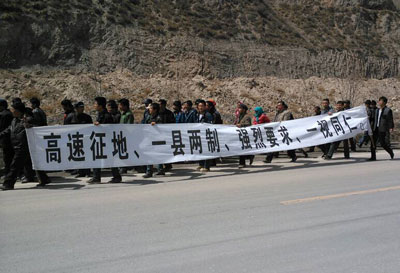
Tibetans carry banners protesting the seizing of their land as they march in Gansu province, April 2, 2014
Photo: RFA
Demonstrations broke out Wednesday, April 2 in Tibet’s Amdo Province as a result of land seizures by the Chinese authorities. Shouting slogans and carrying banners, over a hundred Tibetan protesters marched through Sangchu County’s Hortsang Township, condemning the lack of compensation for Tibetan farmers’ confiscated lands and China’s disastrous environmental record in Northeast Tibet.
The confiscations of Tibetan farmland by Chinese authorities will facilitate the construction of a major new highway as well as the expansion of a number of existing highways. These actions will greatly increase access to state-backed gold mines and a number of industrial plants in the region.
The months leading up to Wednesday’s demonstration were witness to the increasing resentment of the actions of local Chinese authorities by Sangchu County’s Tibetan population: not only had expanding Chinese mining and industrial projects polluted the region’s air and grasslands, but Sangchu’s Tibetan community had been almost entirely excluded from shaping local mining policy, rendering them voiceless concerning the extraction of the area’s mineral resources.
Tibetan residents of Sangchu County first aired their grievances at a two day protest in mid-March, during which a number of protesters were detained and later released. Citizens’ frustrations with local officials reached a tipping point again on Wednesday when the land of Tibetan farmers in Sangchu County was confiscated, its owners were offered nominal compensation, and in some cases, no compensation at all. As a result of the confiscations, many of the farmers are left without a livelihood, and now face a job market in which Han Chinese immigrants and imported labour are often preferred for local jobs.




 Print
Print Email
Email